A Salvaged Banksy Mural is Now on View in NYC
This unique Banksy mural goes up for auction on May 21st in NYC!


 Members of the Bronx Zoo got the chance to try out the new attractions yesterday before they opened to the public.
Members of the Bronx Zoo got the chance to try out the new attractions yesterday before they opened to the public.
As of 10 AM this morning, simply viewing the vast collection of animals and other wildlife isn’t the only way for Bronx Zoo visitors to get in touch with nature. In fact, the zoo just got three times more interactive with the addition of a two-way zip line, an intricate aerial ropes course, and a nature trek.
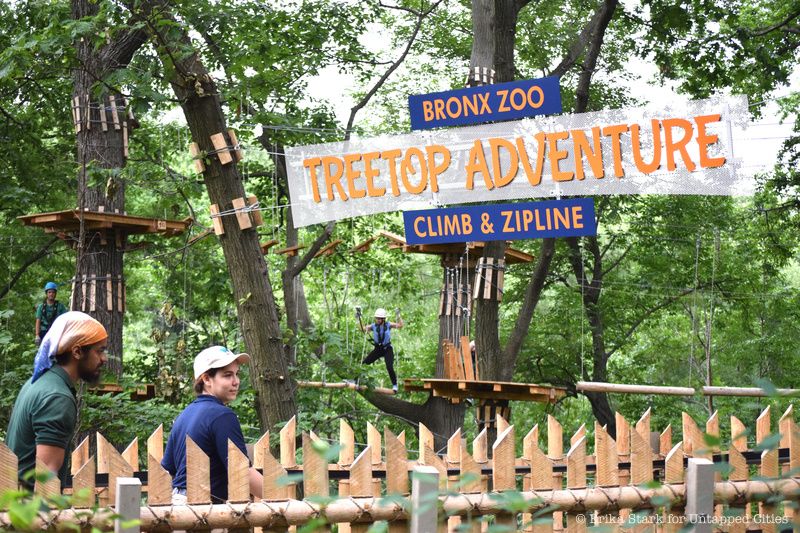
Now officially open to the public, people of all ages, shapes, and sizes are welcome to head to B entrance of the zoo (the river entrance) to take part in the more physically challenging “Treetop Adventure” (zip line and ropes course) or head to the interactive, educational, and family-friendly nature trek just down the road.
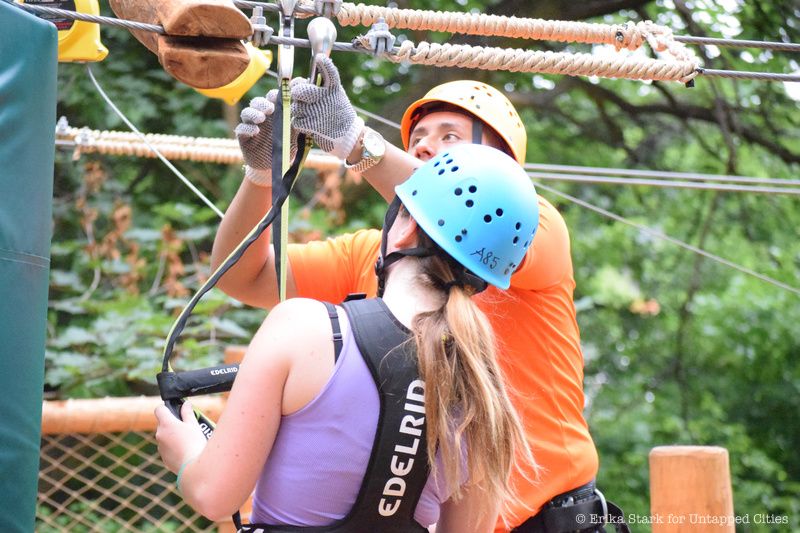
As one of the Wildlife Conservation Society’s (WCS) main attractions (along with Central Park, Queens Park, Prospect Park and the New York Aquarium), the Bronx Zoo is always looking for ways to build on WCS’s mission statement: to “save wildlife and wild places worldwide through science, conservation action, education, and inspiring people to value nature.” The three new additions are right in line with those goals, according to 20-year WCS organizer and current senior director Randi Winter.
Winter, who describes herself as being with the project “since the get-go,” always wants to assure that on the Bronx Zoo’s 260 acres, they “look for every opportunity to connect people with nature.”
“[The new attractions] became a real unique way to utilize our forest in a sustainable and safe way,” Winter adds.
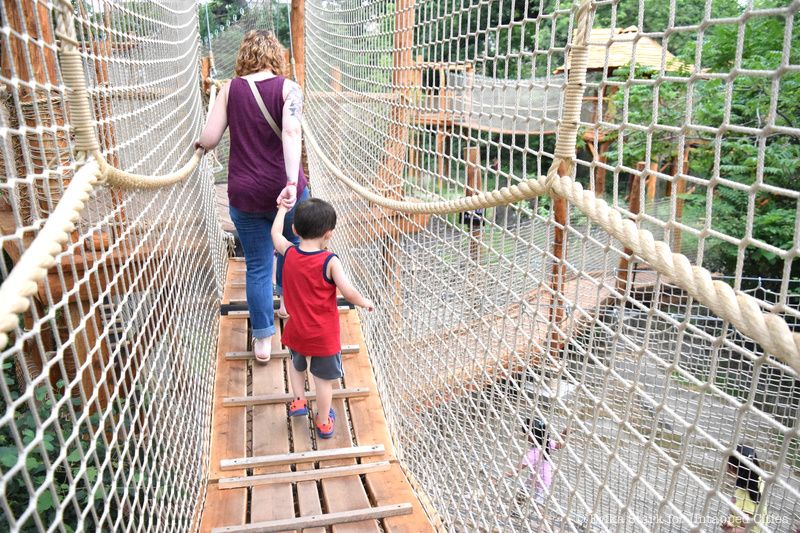
A visiting Mom and her son travel across the ropes course on the “Nature Trek” addition.
The “connection” part of the attractions is of course, the exceptionally interactive, physical and visceral qualities that comes with moving across the zip line or working through a suspended obstacle course.
For those participating either in the zip line or the climb or opting for the full Treetop Adventure (the combination of the two), special-trained workers headed by zip and aerial climb experts are there to walk you through the gearing-up process. After making sure everything is secure, zip-liners will prepare to zip across the Bronx River– the only fresh water river in New York as Winter pointed out. The 400-foot line will take zippers one way before then zipping back to base a few stories up on a higher 400-foot line.

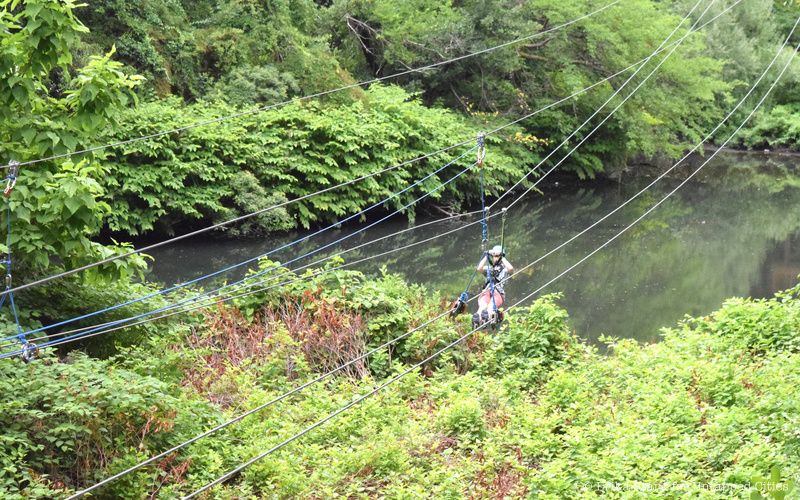
Then at the climb, adventurers will get to move across the tree-top canopy of the forest via 8 – 12 obstacles per course including rope bridges, wobbly bridges, tight rope walks, ladders, rolling and swinging elements, and smaller zip-lines among others. Climbers will also have the ability to choose their degree of difficulty from seven different, color-coded course options – two beginner courses in yellow, two intermediate courses shown in green, two advanced options in blue, and one expert option in black.

However, for zoo-goers with patrons too small to participate in the Treetop Adventure (requirements including being older than 7 years old and heavier than 50 pounds), another interactive nature course called “Nature Trek” isn’t too far away. Located near Asia Plaza in the Southeast Corner of the zoo, activities at the Nature Trek are again parsed by difficulty. At the base level, zoo participants of all ages are invited to hang out in the “Nature Play” area, which consists of several interactive stations encouraging kids to “leap like a frog,” “hide like a lizard,” or “build like a beaver,” among other hands-on, educational activities.

Then, those 3 years of age and up can walk through an ADA accessible rope course (once more tiered into levels of difficulty) with twelve different bridges connected by five towers. The bridges are completely netted for safety and incorporate challenges that require balancing on a narrow beam, weaving between vertical barriers, stretching across wide steps, and climbing on wiggling surfaces. At each tower– look-out type platforms built in a turret fashion– there’s a chance to stop for some bird watching.
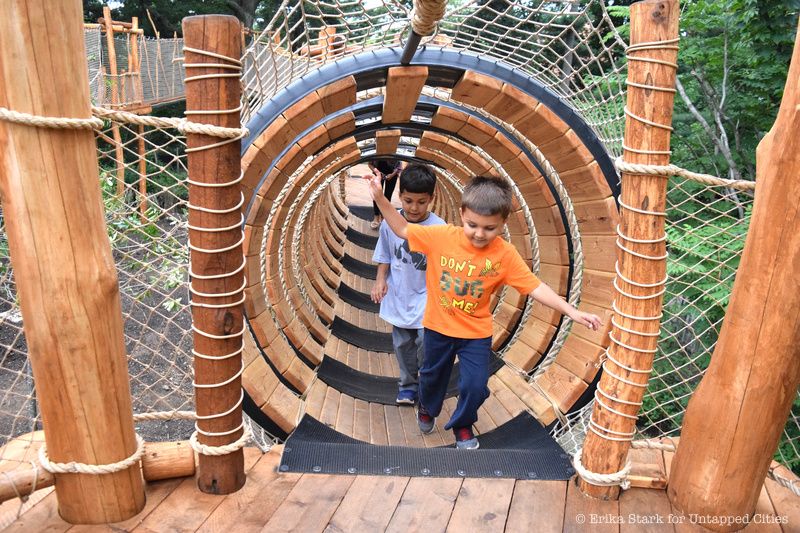
The other half of WCS’s formula has to do with the environmentally-friendly construction of all of these attractions. In partnership with the Green building company ‘Tree-Mendous” (the architects of the courses), WCS has worked to make the courses as non-intrustive to the forest as possible. This involves using a sustainably harvested building material called black locust as well as designing the courses to work around the forest instead of through it.

“We really want all the elements (of the forest) to survive and live on and they rely on the trees for support,” Winter says. “So the way the nature course is built and our ropes course is built is that there’s nothing going through these trees. It all cuffs around the trees so that the forest is able to continue growing while we’re able to enjoy it as well.”
Additionally, one of the things that Winter seemed most excited about in regards to the way the climbing course is constructed, was that zoo patrons can enjoy it year-round. The natural way the course was built has worked doubly as a conservation effort and also has the added bonus of leaving very little in the way of season obstacles. As far as Winter is concerned, “a little bit of rain, a little bit of snow is just another challenge to work through.”

On a July day, with the surrounding landscape as densely green as far as the eye can see, Winter thought ahead to next season. She asks, “I mean, can you image what this forest is going to look like in the fall?” For now, one can only speculate, but luckily this fall at all three attractions, Bronx Zoo goers will be able to see for themselves the changing leaves from tops of the trees.
Next Check out The Top 10 Secrets of the Bronx Zoo in NYC or take a look at Vintage NYC Photography of The Central Park Zoo. Get in touch with the author: @Erika_A_Stark.
Subscribe to our newsletter